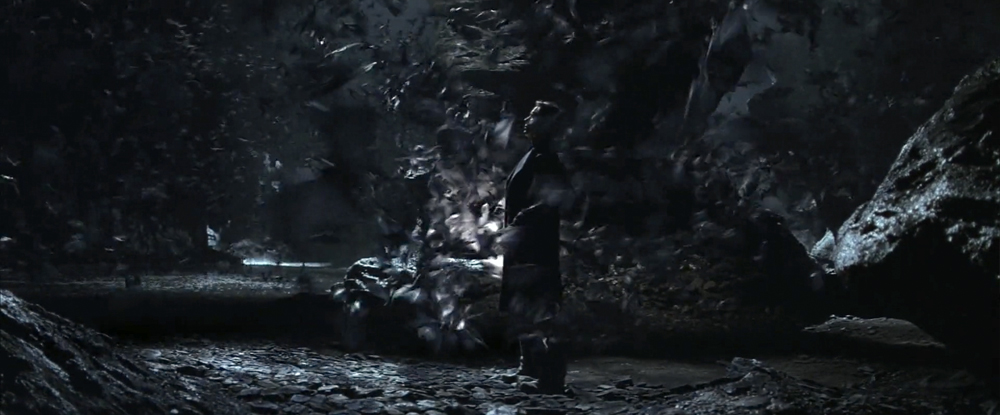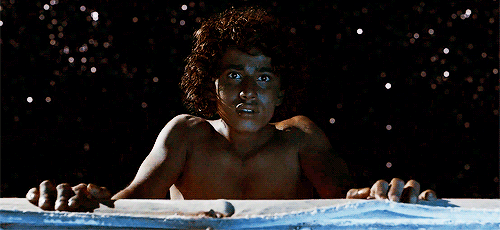Yann Martel’s novel Life of Pi and Christopher Nolan’s (Batman) Dark Knight film trilogy explore the way young men use an animal persona to cope with the anger, rage, fear and violence of traumatic experiences of both a physical and mental nature. The central characters Piscine Patel and Bruce Wayne adopt the symbolic facades of animals to master their fear and separate themselves from their actions and circumstances. This essay explores the origin, formation, utilization and implications of such a phenomenon.
Piscine Molitor Patel and Bruce Wayne both have traumatic childhood experiences with animals that enter their subconscious, where they remain until adulthood. Bruce falls into a well on the family property and is traumatized by a colony of bats. His father rescues him and uses the experience to teach him a lesson, asking, “…why do we fall, Bruce? So we can learn to pick ourselves up.” Pi and his brother Ravi are also taught “a lesson for the rest of [their] lives” by their father, who uses a goat and a tiger to communicate that the one “animal even more dangerous than us [humans is]…Animalus anthropomorphicus, the animal as seen through human eyes.” Young boys look up to their fathers, so when both characters are later orphaned, their subconscious recalls a critical incident from childhood involving fatherly advice. Bruce literally stands in a swarm of bats to become Batman, while Pi, rather than becoming “the next goat” – as Ravi suggests – becomes the mighty Bengal tiger, Richard Parker. Later, both characters choose “Something elemental, something terrifying” to give them courage and the will to go on.
On a visit to the Gotham City Opera, Bruce is visibly distressed by the performers dressed as bats. Like Pi, after seeing the carnage a fully grown Bengal tiger can inflict, young Master Wayne is in near “hysterics”. Leaving the performance via a darkened alley, Bruce’s parents are murdered, while he survives. When the Tsimtsum sinks, Pi too is “alone and orphaned, in the middle of the Pacific”. “To lose your father is to lose the one whose guidance and help you seek, who supports you like a tree trunk supports its branches. To lose your mother…is like losing the sun above you.” Both boys are old enough that they are fully cognizant of the loss, but not old enough to be able to look after themselves, at least initially. Bruce has no one but the faithful butler Alfred to care for him; Pi has a strong belief in God, through the three religions of Hinduism, Christianity and Islam. In effect, they both have surrogate fathers in Alfred and God, but a deep sense of loss, melancholy and anger resides in their psyches.
Under threat from a real, external enemy, yet also facing inner demons stemming from the loss of loved ones, both Bruce Wayne and Pi Patel turn to a subconscious memory of a fearful animal to help them overcome these challenges. Alfred asks Bruce, “Why bats, Master Wayne?” to which he replies, “Bats frighten me. It’s time my enemies shared my dread.” By “adopting the dark” and becoming a symbol of something that scares him, Bruce controls his fear and directs it towards the criminals of Gotham. For Pi, “in the face of such a superior predator, all of us were prey…It seemed the presence of a tiger had saved me from a hyena.” In order to outlast and outmaneuver the Chef/Hyena, Pi adopts the killer instinct and brutal survival drive of Richard Parker. Imagining himself as a predator allows him to feel strong and master his fear.
In Batman Begins, this aforementioned transformation is demonstrated when Bruce rises from a crouch in the cave beneath his mansion, amongst a swirling throng of bats. Wayne declares, “As a man, I’m flesh and blood, I can be ignored, I can be destroyed; but as a symbol… I can be incorruptible, I can be everlasting.” In the novel, Life of Pi, the synonymy of the Indian boy and tiger are merely alluded to in order to preserve the twist ending, however we can observe the same sort of transformation of man into symbol:
“Richard Parker rose unsteadily to his feet on the tarpaulin, eyes blazing as they met mine, ears laid tight to his head, all weapons drawn. I turned around, stepped over the zebra and threw myself overboard.”
Pi throws his figurative sense of self overboard to become a tiger, claiming: “Richard Parker did not jump into the water after me.” In becoming someone else, both characters further lose a part of themselves.
Although Pi has only his own conscience and his belief in an observing God to remind him of his morals, Bruce has a mentor in Henri Ducard/Ra’s al Ghul. Ra’s al Ghul ‘s challenges to Bruce’s self-inflicted torment have equal relevance for Pi:
“You traveled the world… Now you must journey inwards… to what you really fear… it’s inside you… there is no turning back. Your parents’ death was not your fault. Your training is nothing. The will is everything. If you make yourself more than just a man, if you devote yourself to an ideal, you become something else entirely. Are you ready to begin?”
Ra’s al Ghul gives Bruce Wayne the skills and mental strength to become Batman in the same way that the survival manual and a belief in the presence of God help Pi endure 227 days at sea. Pi experiences ‘survivor’s guilt’ and chastises himself for taking the life of the first fish he kills, yet he becomes quite at ease killing by the end of his ordeal. His ability to dispatch the chef and become a savage, meat-eating predator shocks him to the point that his mind performs a reverse anthropomorphization, attributing animal behaviour to his human companions. Alone in a small lifeboat, he remembers his mother on her birthday, yet eventually forgets her face. Ras’s al Ghul echoes this sentiment when speaking to Bruce:
“I know the rage that drives you. That impossible anger strangling the grief, until the memory of your loved one is just… poison in your veins. And one day, you catch yourself wishing the person you loved had never existed, so you would be spared your pain.”
Animal guises provide strength and ability, but they threaten to strip Bruce and Pi of their humanity.
As a devout young man, Pi finds it reprehensible to unnecessarily harm or damage living things, however his circumstances force him to commit sordid and wretched acts. The Joker describes Gotham City’s “morals, [its] code [as] a bad joke! Dropped at the first sign of trouble. They’re only as good as the world allows them to be. When the chips are down, these….these civilized people, they’ll eat each other.” Pi’s simple existence on the lifeboat, devoid of other sustenance forces him to take what he can get, potentially eating his companions, in one reading of the text. He can only be as holy as his physical circumstances allow. Another Dark Knight villain, Harvey Dent, (with the appropriately themed name of Two-Face), tells Batman, “You either die a hero or you live long enough to see yourself become the villain.” Pi could have fought the chef to save the sailor and his mother and died a hero. He could have starved to death alongside his fellow castaways. Instead, his survival instinct and adoption of the symbolic Richard Parker role turns him into a villain of sorts. While Batman declares, “It’s not who I am underneath, but what I do that defines me”, Pi would argue the opposite, “It’s not what [I am forced to] do, but who I am underneath that defines me”. Ra’s al Ghul claims Batman’s “compassion is a weakness his enemies will not share”, but both Bruce and Pi believe compassion and the feelings of regret and remorse for their actions separate them from their respective ‘enemies’: criminals and the French chef.
The long term implications of adopting an animalistic symbol as a persona are significant. Initially embraced as a means of feeling strong in the face of a threat, the bat and tiger fronts consume their hosts. Ra’s al Ghul tells Bruce, “What you really fear is inside yourself. You fear your own power. You fear your anger, the drive to do great or terrible things”. Though ‘The Batman’ is fearless, it is a facade to cover Bruce’s continuing fear. Pi concludes that while he “spent the night in a state of delirium…dreaming of a tiger, [Richard Parker is]…a solid, true thing witnessed while in a weakened, highly agitated state.” His “fear and reason [fight] over the answer” of whether Richard Parker is real, but he is real enough in that he hijacks Pi’s personality and overpowers it for the most of his time on the lifeboat. Pi’s anguish at the tiger not acknowledging him before slipping into the jungle and equally his sorrow at not being able to thank the orange carnivore for saving his life, demonstrate the power Parker has over Pi.
In the film version of Life of Pi, directed by Ang Lee, Pi looks into the ocean and sees Richard Parker as his reflection. The novel provides subtler hints, suggesting Richard Parker’s “head was the size and colour of the lifebuoy, with teeth”, and the “bright orange tarpaulin [was fasted to a] stem – which had a very short prow, what in a face we would be called a snub nose.” Like Bruce in the Batcave, Pi uses his surroundings as inspiration for his alter-ego:
“I perceived an orange mass. It wasn’t a tiger. It was a life jacket. There were a number of life jackets at the back of Richard Parker’s den….between the life jackets, partially….I had my first, unambiguous, clear headed glimpse of Richard Parker.”
Both characters find strength in adopting a persona that possesses the mental resilience and cold action that their boyhood personalities do not. They use these masks to distance themselves from their actions and those on whom they commit violence. As Batman, Bruce Wayne declares:
“They told me there was nothing out there, nothing to fear. But the night my parents were murdered I caught a glimpse of something. I’ve looked for it ever since. I went around the world, searched in all the shadows. And there is something out there in the darkness, something terrifying, something that will not stop until it gets revenge… Me.”
After the creation of the Batman, it emerges that Bruce Wayne is now the mask. Bruce’s friend Rachel surmises “the man who vanished – he never came back at all.” Piscine Molitor Patel, equally, did not survive the sinking of the Tsimtsum; Richard Parker did. When Richard Parker abandoned Pi at the beach in Mexico, Pi felt empty and alone. The survival-hardened Pi offers the Japanese investigators, the writer and the readers, a “better story”: A story about survival, strength, resilience, and a tiger. He prefers the story with animals in the same way Bruce Wayne is more comfortable as Batman. The two orphans of Life of Pi and the Dark Knight trilogy adopt animalistic personas to give them strength in times of suffering and separation from their more brutal actions, but they lose their innocence and sense of individual self in the process.


